Judging the Oceans Views photography contest took hours. It was not because of indecision but because of these extraordinary images that will stop you in your tracks or make you back up and take another look. The experience was like reading a global, visual atlas of the sea. The geographic range of the imagery in the contest is astounding. Once-hard-to-get places are now mainstream destinations that attract curious and ambitious photographers with an appetite for improving their portfolios. Truly remote and “edge of wilderness” places are no longer the exclusive domain of seasoned professionals with a magazine budget behind them. If you can find it on a map, you can get there, shoot it and bring back a set of images that stir the creative bones of others to reach farther, experiment, explore and create.
Underwater image making smashes new ceilings in nearly every publication I look at. There is no one single expert or best photographer or superhero photographer who gets it right with every frame. I hate the words “best,” “most” and “legend,” which somehow get applied to shooters when they have been around long enough to earn some title. Looking at the images in this contest I see images that could grace a cover, become iconic and have the power to create change. We are all out there swimming around with cameras, drawing on curiosity, passion, ambition, talent and technology. The Ocean Views photo contest is a collection of passion and ambition that translates into a collective that can make your head spin. I like looking at images that make me want to go there — that motivate me. Several images in this contest motivated me, got my attention and made me ask questions. That’s what good imagery does.
In every category I see a combination of talent and technology at work. I see point-and-shoot frames that could be magazine covers. I see environments that would fail on 400-speed film that leap to life and become electric in digital. Sensor technology has transformed new shooters into good shooters and good shooters into great shooters. Historically on a typical National Geographic assignment I used to take 500 rolls of film, eight housings, eight cameras and 16 different lenses and a set of backups. The excess baggage fees were blood curdling. All eight cameras would go into the water and come out with a maximum of 288 frames total. I would not see the film for three months. Now I can see the images in a millisecond and make decisions about them. Now we learn from our mistakes instantly — not just from our single-frame triumphs. The immediate feedback has changed the game for all of us. It has raised the bar to new technological heights, but true creativeness still belongs to the individual brain and eye.
Our photographic IQ has quintupled in a decade; images are stronger, say more and are more sophisticated. A picture has about two seconds to grab a viewer’s attention, but it has to have more than a strong subject. It has to have the illusive edge of art. Like music, pictures are a universal language we all can understand. They have power to honor, humiliate, convince the unconvinced, and they have the power to create change.
Keep shooting,
David Doubilet
Grand Prize
Atlantic Bobtails

Tenerife, Canary Islands, Spain
By Pedro Carrillo
Bobtail squids are elusive photo subjects; I’ve gone for years without seeing a single one despite numerous nights diving in the Canary Islands. I was nearing the end of an extensive search when I finally discovered this tiny couple matting. I did not have the right lens for the job — I never imagined they would be so small (approximately a half inch) — but I still managed to shoot a few keepers of that magic instant.
Nikon D200, 60mm f/2.8 AF-D Micro lens, 1/180 sec @ f/22, ISO 320, Seacam Seaflash 250 TTL strobes (2); Seacam housing; www.pedrocarrillo.net
First Place
Napoleon Wrasse Surrounded by Glassfish
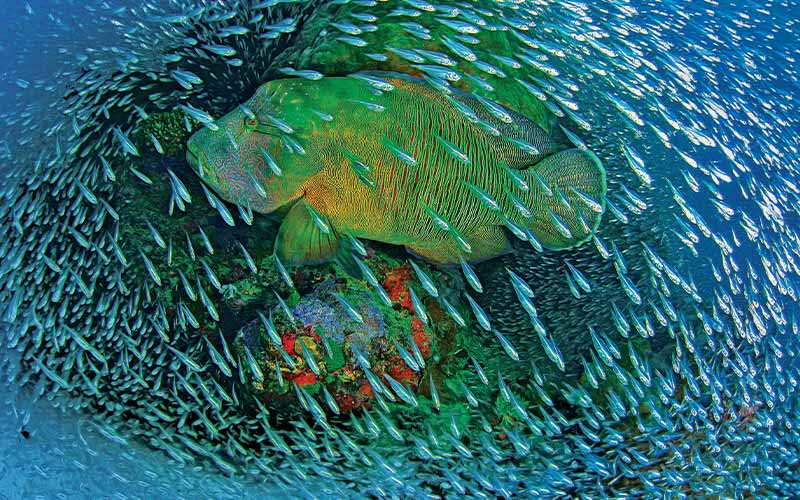
Flynn Reef, Great Barrier Reef, Australia
By Christian Miller
It was the middle of the rain season, and the large quantity of fresh water had turned the ocean green and reduced the visibility to less than 30 feet. I thought I could capture an interesting image by shooting some background subjects through the schooling fish when, unexpectedly, a big Maori wrasse (also known as a Napoleon fish) swam right through the school, which became a living frame.
Nikon D90, Tokina AF 10-17mm f/3.5-4.5 AT-X 107 DX Fisheye lens at 10mm, 1/160 sec @ f/10, ISO 200, Ikelite DS161 strobes (2), Aquatica housing; www.cuckoocrew.com.au
Second Place
Into the Blue
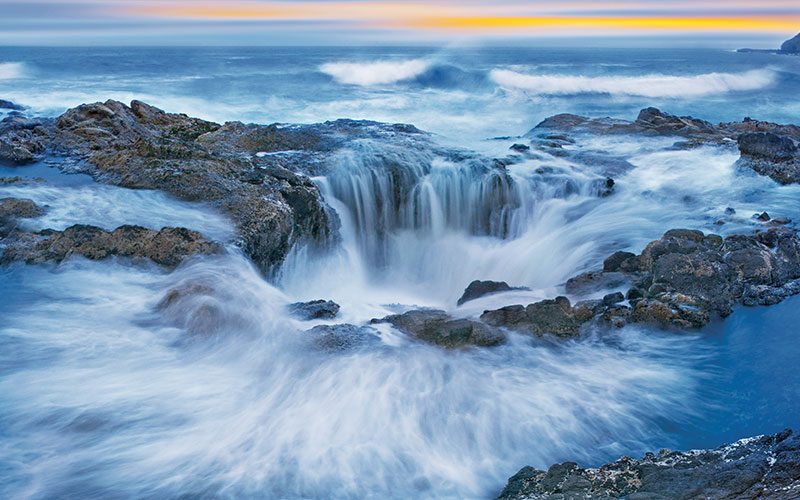
Cape Perpetua, Oregon, USA
By Craig Bill
My favorite of Cape Perpetua’s unique water features is Thor’s Well, also called the Pacific Gateway to the Underworld. The weather was challenging that day, but the water’s energy was on full display. I clicked one exposure after another, wiping my lens often, before wind and rain finally brought an end to the shoot. (See the video)
Sony A77, 24-105mm f/3.5-4.5 lens at 24mm, 1-3 secs @ f/22, ISO 500, Hoya filters (CP, ND8, ND4), Benro tripod, remote IR release, Gitzo ball head, EZ leveler; www.CraigBill.com
Third Place
King Penguin
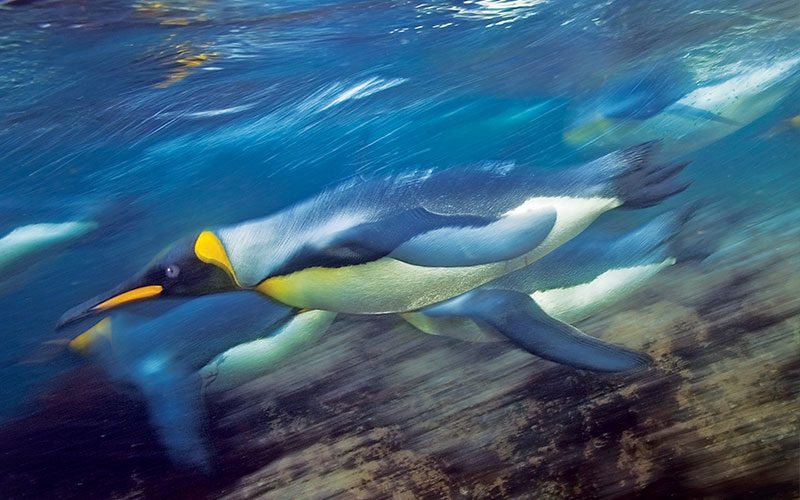
Macquarie Island, Subantarctic Ocean, Australia
By Tobias Bernhard
Macquarie Island’s king penguins have come up with a safe way to avoid the crushing surf and predators such as leopard seals by using a tidal pool with a small, deep channel to the open ocean as a launching point. They were so unfazed by me that they clambered over my back at times to dive into the freezing water.
Nikon D2X, 14mm f/2.8D AF ED lens, 1/20 sec @ f/13, ISO 100, Sea & Sea YS-300 strobes (2), Subal housing, 8-inch dome port and 20mm extension
Fourth Place
Pilot Whales
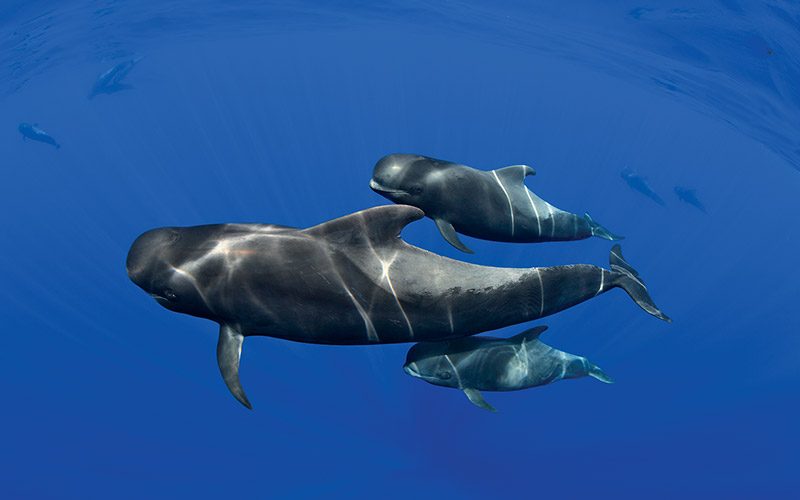
Los Gigantes, Tenerife, Canary Islands, Spain
By Eduardo Acevedo
The Canary Islands are one of the best places in the world to observe pilot whales. You need special permission to swim and take pictures underwater with them, but it can be obtained from the public administration. Summer is the best time for photos because the sea is frequently calm and the visibility in the open ocean can be 200 feet.
Canon EOS 5D Mark II, EF 15mm f/2.8 Fisheye lens, 1/80 sec @ f/9, ISO 200, Seacam housing
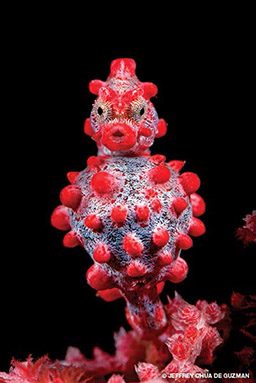
Fifth Place
Pregnant Pygmy Seahorse
Nudi Retreat, Lembeh, Indonesia
By Jeffrey Chua de Guzman
The first step in finding a pygmy seahorse is recognizing the host Muricella gorgonian, and then the search is on for the half-inch-long fish, which looks exactly like one of the coral’s polyps and may or may not actually be there. My goal was to take the best-ever super-macro, head-on photo of a pygmy seahorse.
Nikon D800E, AF-S VR Micro-Nikkor 105mm f/2.8G IF-ED lens, 1/320 sec @ f/45, ISO 80, Sea & Sea YS-250 strobes (2), Nauticam housing, Nauticam Super Macro Converter (+15 diopter)
Sixth Place
Jellyfish (Pelagia Noctiluca) and Juvenile Horse Mackerel
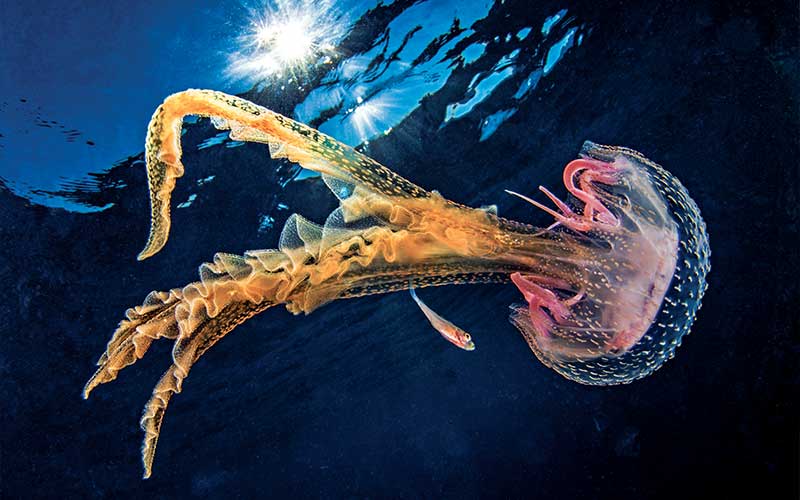
Sorrento, Italy
By Domenico Roscigno
This type of jellyfish does not generally have fish symbionts, but this individual was accompanied by a tiny horse mackerel that hid behind its mantle. I approached with caution so as not to scare the little fish, and I managed to snap this photo with my wide-angle lens.
Nikon D800E, 10.5mm f/2.8 lens, 1/320 sec @ f/22, ISO 100, Inon Z-240 strobes (2), Seacam housing, Seacam Fisheye macro port, 45-degree viewfinder
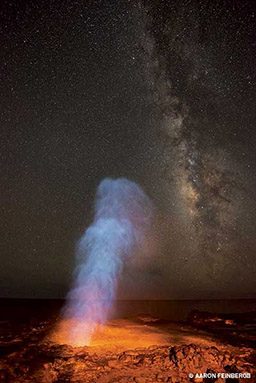
Seventh Place
Milky Way over Spouting Horn
Po’ipu, Kaua’i, Hawai’i, USA
By Aaron Feinberg
Spouting Horn is a hugely popular attraction; the ocean is forced through an old lava tube and sprays upward like a geyser, making a huge, startling, whistling sound. I spent an hour rattling off 25-second exposures and playing with the lighting, all while waiting for the right wave to send the spray shooting upward but not blocking the stars.
Nikon D800, 14-24 f/2.8 lens, 25 secs @ f/3.2, ISO 3200, Manfrotto 055CXPROB tripod, Nikon SB-900 Speedlight, gel; www.expandingvisualreality.com
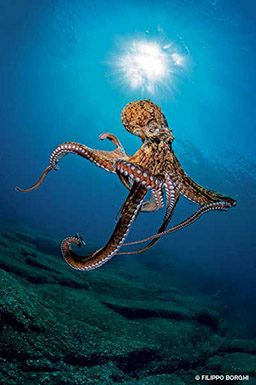
Eighth Place
Octopus
Giannutri Island, Italy
By Filippo Borghi
This curious octopus approached me and after a few minutes began jumping with all its tentacles spread. To capture the action, I tried to fix the flash setting and began to shoot whenever the octopus launched from above to immortalize this unusual but impressive attitude.
Nikon D800, Tokina AF 10-17mm f/3.5-4.5 DX Fisheye lens, 1/125 sec @ f/16, ISO 100, Ikelite DS160 strobes (2); Subal housing
Ninth Place
Green Turtle
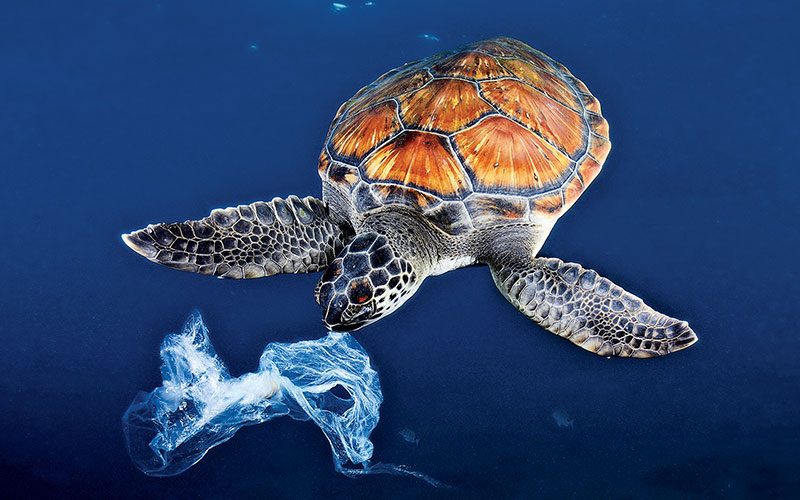
Armeñime, Tenerife, Canary Islands, Spain
By Sergi Garcia
The resemblance of plastic bags to jellyfish is a constant danger, as the turtles ingest the bags by mistake. Many of them die from asphyxia or obstructed digestive tracts. We did not let this turtle eat the bag, but the oceans are riddled with these bags, and they are ours. I took only three shots because removing the bag took precedence.
Nikon D7000, Tokina AF 10-17mm f/3.5-4.5 DX Fisheye lens at 12mm, 1/100 sec @ f/10, ISO 100, Inon Z-240 strobes (2), Nauticam housing; www.sgfoto.eu
Tenth Place
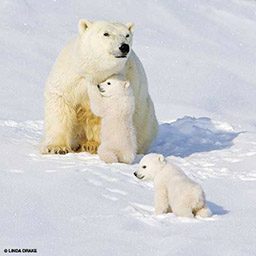
Mother Polar Bear with Cubs
Churchill Wildlife Management Area, Manitoba, Canada
By Linda Drake
Even after many years of watching mother polar bears with their cubs, it still amazes me to see how gentle these huge carnivores are with their young. The cubs tug on their mother’s ears, play and wrestle on top of her head and bite at her nose, cheeks and ears, while she remains calm and undisturbed.
Canon EOS-1D Mark II, 500mm f/4 lens with 1.4 extender, 1/1000 sec @ f/13, ISO 400, Bogen CF tripod with Really Right Stuff ballhead and Wimberley sidekick; www.LindaDrake.com
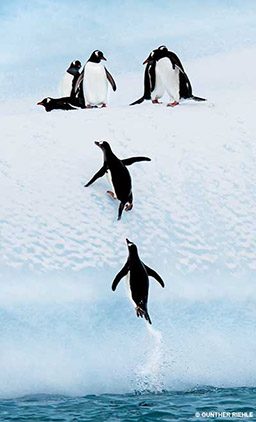
Eleventh Place
Gentoo Penguins
Wilhelmina Bay, Antarctic Peninsula
By Gunther Riehle
We were cruising through Wilhelmina Bay in Zodiacs in search of humpback whales when a beautiful, bluish iceberg with a layer of fresh snow appeared. It was attractive not only to us humans but also to a troop of Gentoo penguins. The iceberg had a 6-foot-high vertical wall at the waterline, and the power with which these little birds propelled themselves out of the water was incredible.
Nikon D4, 80-400mm f/4.5-5.6 lens, 1/8000 sec @ f/5.3, ISO 800, B+W polarizing filter, hand-held from Zodiac
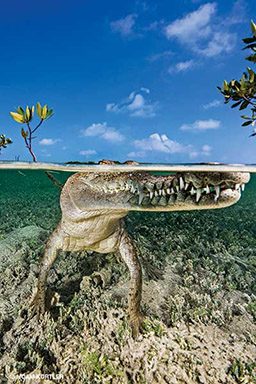
Twelfth Place
Crocodile
Jardines de la Reina, Cuba
By Noam Kortler
When we arrived at the mangrove lagoon, the divemaster started shouting “Niño, niño,” and after a few minutes this young crocodile appeared. We were amazed to see it respond to his voice. Eventually I gained the confidence to get close enough to the crocodile to get the over-under shot I had in mind.
Nikon D800, AF-S Nikkor 16-35mm f/4G ED VR lens at 16mm, 1/200 sec @ f/14, ISO 100, Seacam Seaflash 150 strobes (2), Seacam housing; www.nemodivers.co.il
Thirteenth Place
Marine Iguana

Fernandina Island, Galapagos, Ecuador
By Filippo Borghi
On the way back from the far north islands of the Galapagos archipelago, we decided to change our route and head toward Fernandina for a day of photographing marine iguanas underwater. After more than a half hour of searching I finally encountered one. To my amazement it did not stray but rather seemed intrigued, looking right into the lens between mouthfuls.
Nikon D800, Tokina AF 10-17mm f 3.5-4.5 DX Fisheye lens, 1/125 sec @ f/10, ISO 250, Ikelite DS160 strobes (2), Subal housing
Fourteenth Place
Iceberg on Black Sand Beach
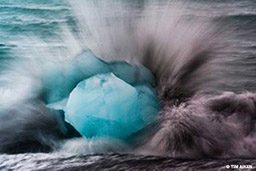
Jokulsarlon Lagoon, Iceland
By Tim Aiken
Instead of recreating shots previously taken of this beach, I hoped to capture something new. On the day I visited, large waves were pummeling marooned slabs of ice. As water spiraled into the air, it carried black sand that gave the icebergs a watery halo.
Nikon D700, 70–200mm f/2.8 lens at 200mm, 1/5 sec @ f/4, ISO 200, Manfrotto 293 tripod and mini ball head; www.timaiken.org
Fifteenth Place

Arch Rock and Kelp
Anacapa Islands, Channel Islands National Park, California, USA
By Antonio Busiello
I wanted to capture in a single photo the beauty of Anacapa and the Channel Islands both above and below the water. On the day of the shoot everything was perfect: calm water, no current, strong sun and great visibility. I floated on the surface for only a short time before I got the picture I wanted.
Nikon D200, 10.5mm f/2.8 lens, 1/320 sec @ f/9, ISO 200, Sea & Sea YS-250PRO strobes (2), Sea & Sea housing; www.antoniobusiello.com
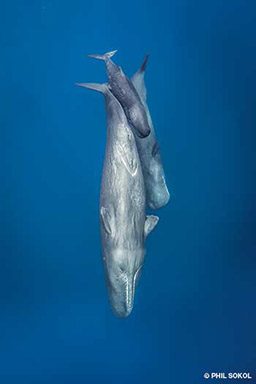
Sixteenth Place
Sperm Whales
Dominica
By Phil Sokol
After several days of fruitless searching we finally came upon a group of sperm whales socializing on the surface. Moments after I entered the water I saw another small group diving under me; the largest whale rolled over as if to inspect the strange, gangly creature that was now in their world.
Canon EOS 5D Mark III, Sigma 15mm fisheye lens, 1/160 sec @ f/8, ISO 320, Nauticam housing; www.philsokol.com
Highly Honored
Needlefish Reflection

Bonaire, Netherlands
By Todd Bretl
I surfaced from a night dive to find needlefish hunting small minnows at the surface. In the darkness I had to use focus lights to frame and focus the shot. As soon as I put my light on the needlefish, massive tarpon would burst from the depths and eat the needlefish before I could even take a shot. I had to turn off my lights, adjust my eyes to the darkness and prefocus my lens. Without the artificial light, these needlefish could eat in peace, and I got the shot I was hoping for.
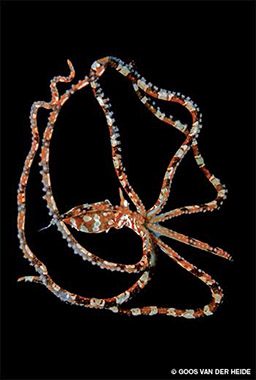
Nikon D7100, 105mm f/2.8G IF-ED micro lens, 1/320 @ f/11, ISO 100, Inon Z-240 strobes (2), Nauticam housing; www.toddbretl.com
Wonderpus
Bangka Island, North Sulawesi, Indonesia
By Goos van der Heide
During a dive at Bangka Island’s house reef I found this wonderpus swimming at 33 feet.
Canon EOS 5D Mark II, EF 100mm f/2.8 Macro IS USM lens, 1/80 sec @ f/20, ISO 100, Seacam Seaflash 250 strobe at 1/4 power, Seacam housing; www.lightsinblue.com
Blue Shark and Diver
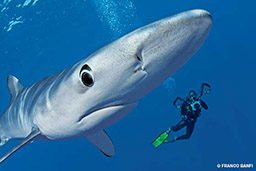
Pico Island, Azores, Portugal
By Franco Banfi
I was at Pico Island with a group of friends and photographers to photograph blue sharks. Each day we went out onto the open sea in a Zodiac. One time I was in the water with three or four sharks swimming around me, sometimes coming very near. This situation gave me the idea to photograph a shark up close with a fisheye lens and fill the rest of the frame with a diver.
Canon EOS 5D Mark II, 15mm f/2.8 fisheye lens, 1/160 sec @ f/11, ISO 320, Seacam Seaflash150 strobes (2) at half power, Subal housing; www.banfi.ch
Mobula Rays
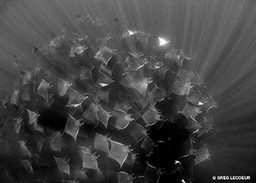
La Paz, Baja California Sur, Mexico
By Greg Lecoeur
On my way out for a dive, I had the privilege of witnessing a wonderful gift from nature: mobula rays breaking the surface and flying above the water. I spotted a huge shadow moving slowly beneath the boat, so I put on my dive gear and jumped into the water. There I discovered this massive sphere of mobula rays in the foggy depths.
Nikon D7000, Tokina AF 10-17mm f/3.5-4.5X DX Fisheye lens, 1/400 sec @ f/3.5, ISO 200, Ikelite housing; www.greglecoeur.com
Scripps Pier and Surfer

La Jolla, California, USA
By Craig Bill
I always thought Scripps Pier was a great photo subject, but when I arrived the air was hazy and thick, which made for a brassy and unremarkable sky. At the end of the sun’s journey, a fantastic display of color flashed across the sky, soaking the entire area with a warm glow. It was the sunset I had hoped for. (See the video.)
Sony A77, 24-105mm f/3.5-4.5 lens at 24mm, 1/25 sec @ f/22, ISO 1600, remote IR release, Gitzo ball head, EZ leveler; stitched panorama; www.CraigBill.com
Gray Triggerfish (Balistes capriscus)
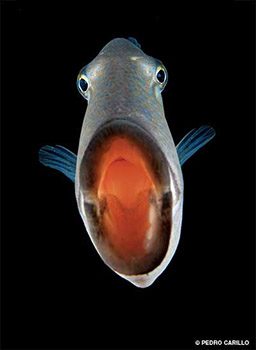
Sardina, Gran Canaria, Canary Islands, Spain
By Pedro Carrillo
Triggerfish are always curious and sometimes aggressive photo subjects, so it is no surprise that they provide wonderful opportunities for underwater photographers. This was certainly the case with the group of gray triggerfish I encountered off Sardina last summer. They would get quite close to my camera housing to inspect their reflections in the glass dome, sometimes biting it hard, becoming very annoyed at what seemed to be another defiant triggerfish. The photo doesn’t do justice to the fish’s massive teeth (they are out of focus due to their extreme proximity to the camera), but this encounter made me thankful I have a resilient glass dome!
Nikon D200, Tokina AF 10-17mm f/3.5-4.5 AT-X 107 DX fisheye lens at 13mm, 1/250 sec @ f/19, ISO 160, Seacam Seaflash 250 TTL strobes (2), Seacam housing; www.pedrocarrillo.net
© Alert Diver — Q2 Spring 2014